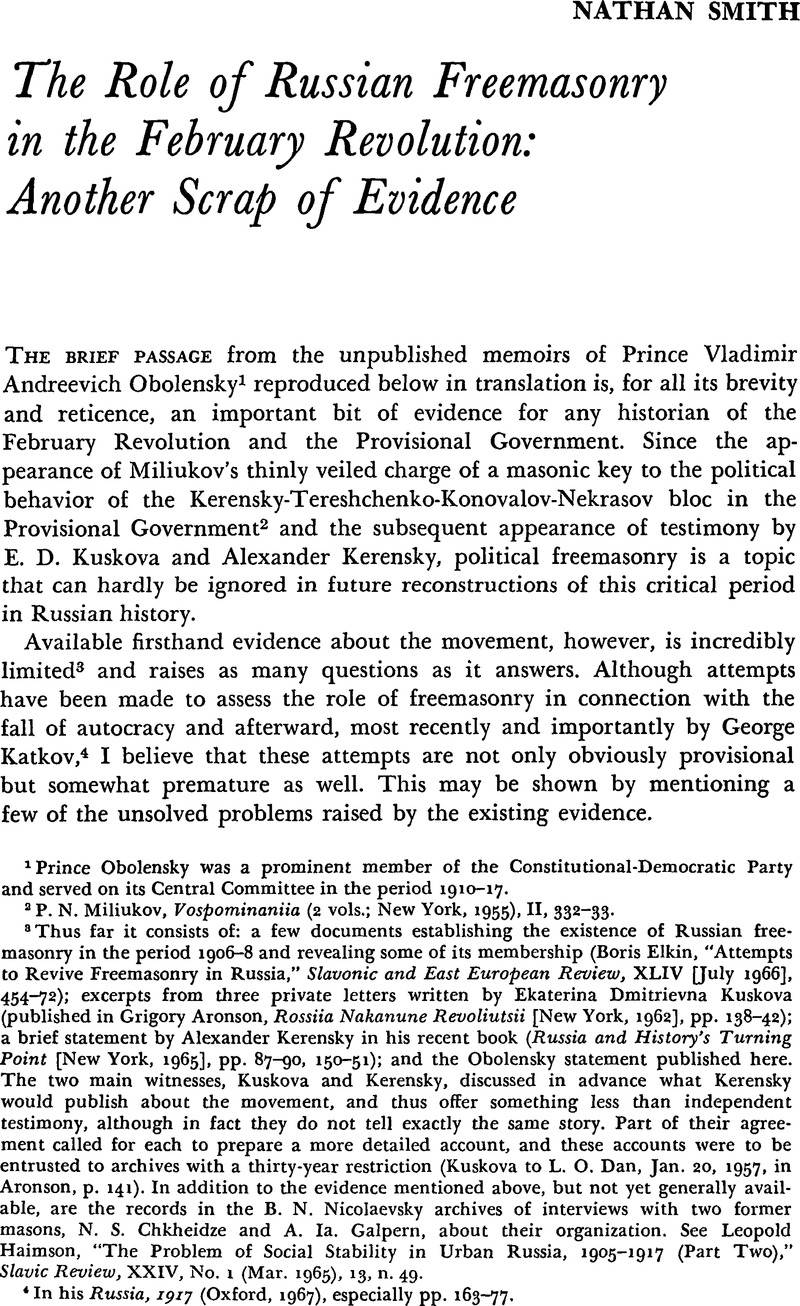Published online by Cambridge University Press: 27 January 2017

1 Prince Obolensky was a prominent member of the Constitutional-Democratic Party and served on its Central Committee in the period 1910-17.
2 Miliukov, P. N., Vospominaniia (2 vols.; New York, 1955), II, 332–33.Google Scholar
3 Thus far it consists of : a few documents establishing the existence of Russian freemasonry in the period 1906-8 and revealing some of its membership ( Boris, Elkin, “Attempts to Revive Freemasonry in Russia,” Slavonic and East European Review , XLIV [July 1966], 454–72Google Scholar); excerpts from three private letters written by Ekaterina Dmitrievna Kuskova (published in Grigory, Aronson, Rossiia Nakanune Revoliutsii [New York, 1962], pp. 138–42Google Scholar); a brief statement by Alexander Kerensky in his recent book (Russia and History's Turning Point [New York, 1965], pp. 87-90, 150-51); and the Obolensky statement published here. The two main witnesses, Kuskova and Kerensky, discussed in advance what Kerensky would publish about the movement, and thus offer something less than independent testimony, although in fact they do not tell exactly the same story. Part of their agreement called for each to prepare a more detailed account, and these accounts were to be entrusted to archives with a thirty-year restriction (Kuskova to L. O. Dan, Jan. 20, 1957, in Aronson, p. 141). In addition to the evidence mentioned above, but not yet generally available, are the records in the B. N. Nicolaevsky archives of interviews with two former masons, N. S. Chkheidze and A. la. Galpern, about their organization. See Leopold, Haimson, “The Problem of Social Stability in Urban Russia, 1905-1917 (Part Two),” Slavic Review , XXIV, No. 1 (Mar. 1965), 13, n. 49.Google Scholar
4 In his Russia, 1917 (Oxford, 1967), especially pp. 163-77.
5 “Attempts to Revive Freemasonry,” p. 472.
6 Kuskova to N. V. Volsky, Nov. 15, 1955, in Aronson, pp. 138-40.
7 Russia and History's Turning Point, p. 88.
8 See especially the last paragraph of his statement below, which suggests that it was quite normal for a Russian mason to transfer to a French lodge after the Bolshevik Revolution.
9 Katkov, without directly raising or solving the problem, passes the hurdle by assuming that political freemasonry was a “new secret society connected with and modelled on masonic lodges” (p. 163). He postulates a “temporary cessation of masonic activities” and a “resurgence” in 1915 (pp. 164, 167). Aronson handles the same problem as follows : “The rebirth and activization of the latest masonry relates, obviously, to 1915 … “ (p. 121).
10 Kuskova to Volsky, Nov. 15, 1955, and to Dan, Feb. 12, 1957, in Aronson, pp. 139, 141-42. Katkov has probably fallen into this snare when he quotes Kuskova on the need to win over the military and convert important professional societies into propaganda arenas (pp. 169-70). Katkov treats this as referring to the immediate background of the February 1917 revolution, but the context of Kuskova's letter makes it more likely that she was referring here to the period of the 1905 revolution.
11 Miliukov, p. 333; Kuskova to Volsky, Nov. 15, 1955, in Aronson, p. 139.
12 Katkov, p. 172; Aronson, p. 122.
13 Kuskova to Dan, Feb. 12, 1957, in Aronson, p. 142; Kerensky, p. 90.
14 This passage is taken from Kn. V, A. Obolensky, “Moia Zhizn’ i Moi Sovremenniki.” The memoirs were begun sometime after 1933 and were completed, apparently, in 1937. The original typescript is now in the possession of his son Serge Obolensky, who was kind enough to furnish the writer with a copy.
15 Cf. Katkov, who asserts that “party allegiances and party discipline had to yield to the stronger tie of the masonic bond” (p. 171).